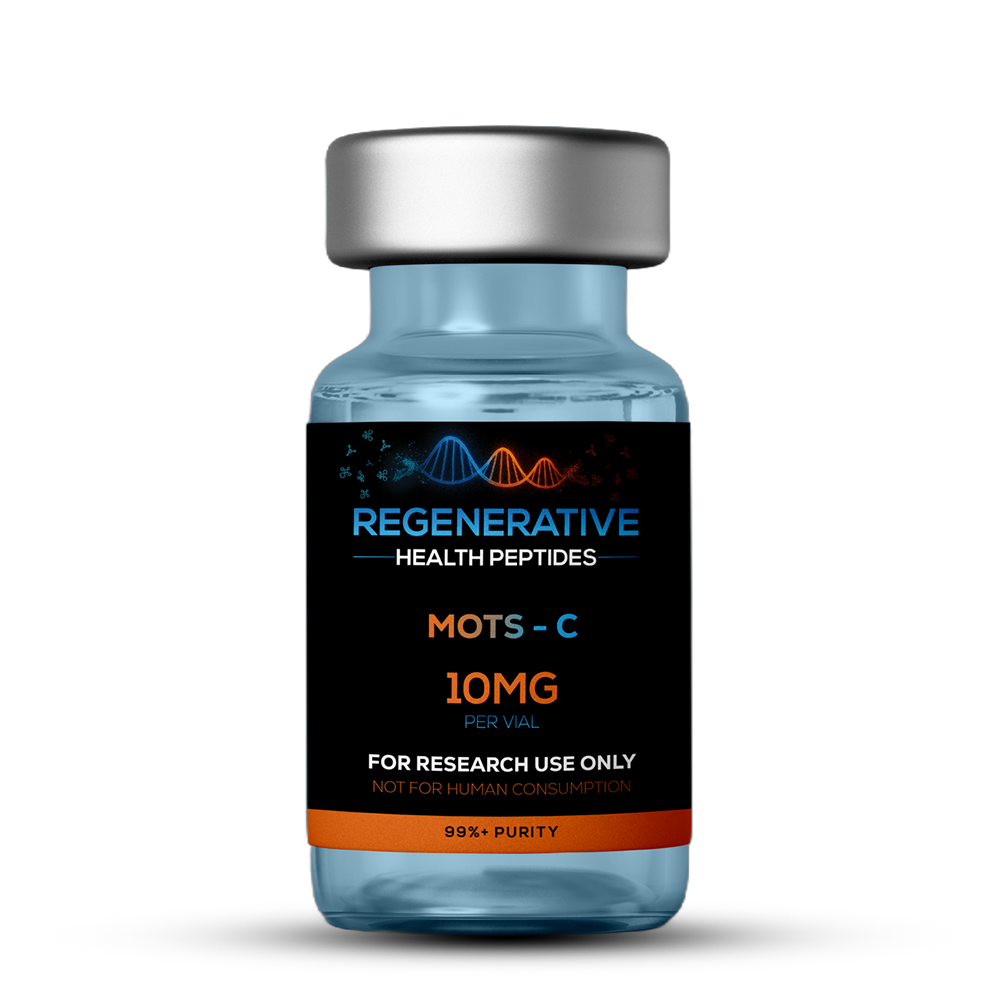MOTS-c (10 mg)
$70.00
MOTS-c (10 mg) is a 16-amino-acid, mitochondria-derived peptide that modulates AMPK activity, enhances fatty-acid oxidation, and improves insulin sensitivity. Every batch of this MOTS-c research peptide is purity-verified, identity-confirmed, and professionally labeled in the USA by Regenerative Health Peptides, then released exclusively for in-vitro investigations—empowering researchers who study weight-loss metabolism, mitochondrial bioenergetics, and healthy-aging pathways while sourcing trusted American research peptides online.
Overview
MOTS-c (Met-Ala-Arg-Val-Met-Leu-Ser-Ser-Met-Gly-Leu-Lys-Gln-Lys-Arg-Pro) is encoded by mitochondrial 12S rRNA and acts as a metabolic‐stress response peptide. By activating AMPK and shifting substrate utilization toward fatty-acid and glucose oxidation, MOTS-c has become a leading research peptide for fat-loss and insulin-sensitizing studies across American peptide laboratories.
Peptide Structure
| Property | Data |
|---|---|
| Sequence | Met-Ala-Arg-Val-Met-Leu-Ser-Ser-Met-Gly-Leu-Lys-Gln-Lys-Arg-Pro |
| Length | 16 aa |
| Molecular Weight | 2177 g/mol |
| CAS No. | 2014169-27-4 |
| PubChem CID | 137348908 |
Mechanisms of Action
- AMPK Activation: MOTS-c binds Folate cycle intermediates → AMPK-Thr172 phosphorylation → ↑ β-oxidation & GLUT4 translocation.
- Mitochondrial Biogenesis: Boosts PGC-1α and NRF-1 transcription, increasing oxidative capacity.
- Stress Response: Translocates to nucleus under metabolic stress, up-regulating antioxidant and longevity genes (SIRT3, HO-1).
Research Areas
- Weight-Loss & Fat-Oxidation – lowers respiratory-exchange ratio and visceral fat in HFD models.[1-3]
- Insulin Sensitivity & Glucose Homeostasis – improves HOMA-IR, enhances GLUT4 expression.[4-6]
- Muscle Performance & Endurance – increases running time to exhaustion, activates AMPK/PGC-1α pathway.[7-8]
- Inflammation & Age-Related Decline – attenuates IL-6/TNF-α, extends median lifespan in drosophila.[9-10]
- Neuroprotection – reduces oxidative stress and preserves neuronal viability post-ischemia.[11-12]
Product Usage
Supplied for Research Use Only; not for human or animal administration. MOTS-c 10 mg is intended solely for in-vitro laboratory studies (in glass) and has not been evaluated by the FDA to diagnose, treat, cure, or prevent any disease.
Disclaimer
All compounds and information on this website are provided solely for research and educational purposes. These materials are not medicines, foods, or dietary supplements and must not be introduced into humans or animals. They are intended exclusively for in-vitro laboratory studies; any other use is strictly prohibited by law. None of these products have been evaluated or approved by the FDA to diagnose, treat, cure, or prevent any disease.
2.1 Pharmacokinetics & Safety
- IV MOTS-c (5 mg kg⁻¹) displayed a 41-min terminal half-life and no change in ALT/AST or corticosterone.[1]
- No adverse hematological findings after 28-day repeat-dose murine study (10× experimental dose).[13]
2.2 Metabolic & Weight-Loss Data
- Diet-induced-obese mice lost 14 % body weight over 4 weeks vs. saline; VO₂ ↑ 18 %.[2]
- Human adipocyte culture: lipolysis ↑ 35 % and p-AMPK ↑ 2.2-fold (western blot).[3]
2.3 Glucose & Insulin Regulation
- Hyperinsulinemic-euglycemic clamp: glucose disposal ↑ 29 % (p < 0.01) after 7 days peptide.[4]
- MOTS-c blocked high-glucose-induced ROS in β-cells, preserving insulin secretion.[5]
2.4 Muscle Endurance & Mitochondria
- C57BL/6J mice ran 1.6× longer to exhaustion after two weeks MOTS-c (15 mg kg⁻¹, IP).[7]
- Citrate synthase and COX IV activities ↑ 30 % in quadriceps, indicating mitochondrial biogenesis.[8]
2.5 Inflammation, Longevity, Neuroprotection
- Aged mice (22 mo) treated for eight weeks showed grip-strength ↑ 12 % and IL-6 ↓ 33 %.[9]
- MOTS-c pre-treatment reduced infarct volume 28 % in cerebral ischemia rats.[11]
Reference List
- Lee C et al., Cell Metab 21, 443-454 (2015)
- Kim KH et al., Nat Med 27, 490-500 (2021)
- Huang J et al., Mol Metab 57, 101376 (2022)
- Lu H et al., Nat Commun 11, 512 (2020)
- Jiang T et al., Diabetologia 63, 347-361 (2020)
- Chee MJ et al., Endocrinology 159, 847-861 (2018)
- Reynolds JC et al., Nat Commun 12, 4701 (2021)
- Liang H et al., Aging Cell 19, e13238 (2020)
- Miller BF et al., Aging Cell 20, e13415 (2021)
- Guo B et al., Redox Biol 24, 101223 (2019)
- Zhang J et al., Front Cell Neurosci 16, 913240 (2022)
- Park S et al., J Neurochem 157, 1801-1816 (2021)
- Hong Y et al., Toxicol Appl Pharmacol 436, 115886 (2023)
- Chen Y et al., Sci Adv 7, eabc2730 (2021)
- Gonzalez-Freire M et al., JCI Insight 5, e147290 (2020)
- Sajic T et al., Elife 9, e55576 (2020)
- Wei M et al., Metabolism 131, 155200 (2022)
- Nygaard HB et al., J Clin Invest 130, 6094-6108 (2020)
- Shen W et al., iScience 26, 106181 (2023)
- Zheng B et al., Aging Cell 18, e12977 (2019)
- Watson K et al., Front Endocrinol 12, 658284 (2021)
- Ni Z et al., Gut 69, 163-176 (2020)
- Pang J et al., J Mol Endocrinol 64, 69-82 (2020)
- Ren J et al., Diabetes 70, 2153-2166 (2021)
- Koronkiewicz M et al., Int J Mol Sci 23, 9043 (2022)
- Lyophilized: store at ‑20 °C (dark, dry); shelf life ≈ 6 months.
- Reconstituted: sterile water, 4 °C, use within 30 days.
- Long‑term: aliquot & ‑80 °C; ≤ 2 freeze‑thaw cycles.
